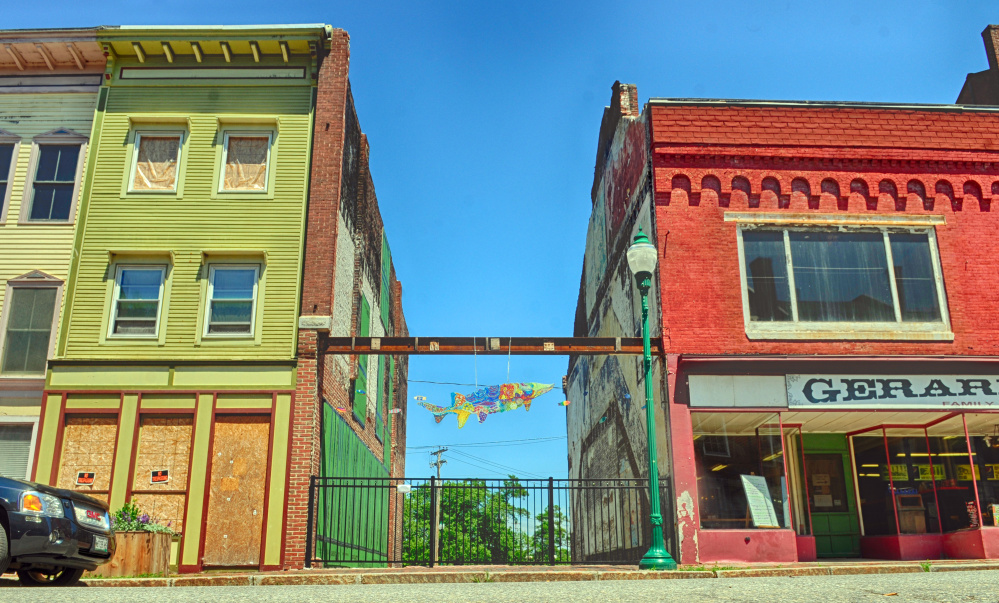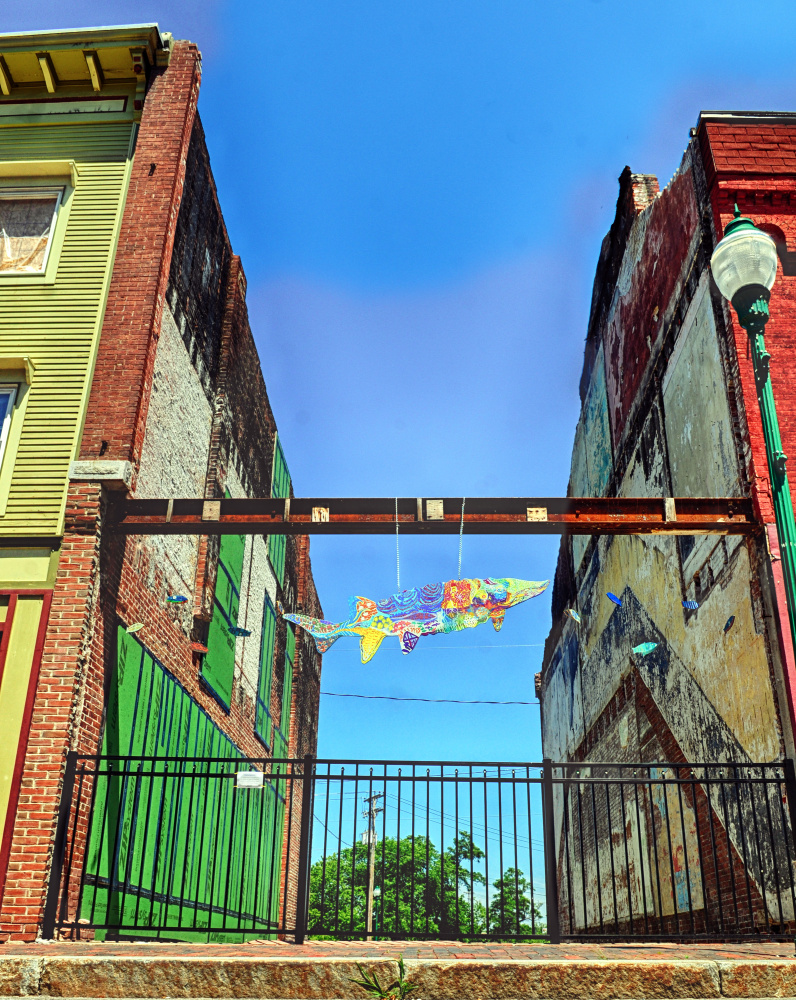GARDINER — Boarded-up windows and a vacant space are the only indications that remain of the fire that destroyed one building and damaged four others one year ago in downtown Gardiner.
“There’s certainly a personal sadness for me every time I walk or drive by that empty space,” Gardiner Mayor Thom Harnett said recently. “Losing a piece of downtown is like losing a piece of the Gardiner family.”
The fire, Harnett said, made people think of downtown Gardiner in a different way.
“It showed how important it is to our economy,” he said. “It’s what makes Gardiner a city and a place for people to congregate, and people have picked up on that.”
Before the fire, Water Street had been the focus of community development efforts, with new retail businesses such as the Gardiner Co-Op and the Touch of Grey tattoo salon moving into street-level spaces and planned renovations to other buildings such as Johnson Hall in the works.
All of that activity and momentum appeared to grind to a halt shortly before 4:30 that warm Thursday afternoon, when the first firetrucks arrived.
The only indication that something was wrong on Water Street one year ago was the drift of smoke that seeped out of the front of 235 Water St.
The story from the back side of the building, the side that faces the Arcade parking lot and Cobbosseecontee Stream, was very different. Shortly before 4:30 p.m., heavy fire was showing from a second-floor window in the rear and the smoke detectors in the buildings were shrieking.
For the next eight hours, the Gardiner Fire Department, joined by units from Augusta, Togus, Pittston, Randolph and Farmingdale, then Hallowell, West Gardiner, Litchfield, Winthrop, Winslow and Topsham, worked to knock down and put out the fire, but not before it spread west into 243 and 251 Water St., and not before the roof of 235 caved in.
“I’ve been at bigger fires,” Gardiner Fire Chief Al Nelson said earlier this week, sitting in the relative quiet of the fire station just off Church Street. When downtown fire broke out, Nelson had been fire chief in Gardiner for less than a year. He had retired in 2009 as battalion chief from the Augusta Fire Department and worked as a nurse for a few years at VA Maine Healthcare Systems at Togus before he was hired in Gardiner.
But the downtown Gardiner fire, coming only months after the fire that destroyed half the senior apartment complex Highland Terrace, presented tactical challenges he hadn’t seen before as an incident commander. Because the building was in the middle of a block of connected buildings, it was fought on two sides and with only radio communication between Nelson and Jason Farris, battalion chief at the Augusta Fire Department.
“It was easier to meet the challenge because we know each other and we know how the other thinks,” he said. “The relationship we’ve had for years certainly helped.”
In the fire’s immediate aftermath, when some of the building’s occupants were unaccounted for, the focus was on searching the rubble. Eventually, those residents were found safe, but they had lost everything they owned. The cause of the fire was undetermined.
HISTORIC FIRES
A year later, the remains of 235 Water St. have been knocked down and hauled away. All that remains is a beam that bridges the gap between Gerard’s Pizza at 227 Water St. and the fire-damaged building at 243.
The beam is the home to an art installation of a painted sturgeon and alewives that’s a collaboration of SpinOff Studio, Gardiner Main Street’s streetscape team and Upstream, a nonprofit dedicated to restoring the alewife run to Cobbosseecontee Stream.
The buildings at 243 and 251 Water St. remain vacant and boarded up.
“It’s a miracle we have any buildings in downtown Gardiner when you look at the history,” Patrick Wright said. Wright is the executive director of Gardiner Main Street and is the economic development coordinator for the city of Gardiner.
In many ways, fire has shaped and reshaped Gardiner’s downtown for decades. The archive in Gardiner Public Library contains accounts of fires large and small dating back to the 19th century, when fires were fought with bucket brigades. Historic photos show buildings in and around downtown Gardiner that no longer exist, mostly because they burned.
In 1860, a fire broke out in a sawmill on the First Mile Bridge, burning five mills, all the shops and other buildings on the bridge and homes on High and Summer streets. A little more than two decades later, the great fire of 1882 burned over the same area as the 1860 fire, although more property was destroyed. A second fire that year burned at the lower end of Water Street.
A century ago, Gray’s mill, the Gray-Hildreth grist mill, the Oakland Co. planing mill and the woolen mill burned in the city’s biggest fire since 1882.
More recently, the American Tissue plant was flattened by fire in 1970, fire destroyed a block of buildings in 1985 on the site of what’s now McKay Park, and the Yorketown paper mill was torched in 2009.
WHAT’S NEXT
Wright said if anyone has tracked the economic impact of the 2015 fire, he’s not aware of it. Clearly, the damage to the buildings and the loss of 235 Water St. would be reflected in the city’s valuation, he said. In addition, downtown Gardiner was essentially shut down for two days after the fire, and Gerard’s was closed for more than three weeks to clean up the smoke and water damage.
“You never like to have empty spaces downtown,” said Clare Marron, owner of Monkitree Gallery on Water Street. “First-floor space that’s retail is important where foot traffic is important.”
Wright said studies have shown that empty spaces make shoppers uncomfortable and they tend to avoid areas with vacant storefronts.
It’s unclear what will happen with the vacant buildings. The owners of the buildings did not return calls for comment. Wayne Chamberland, owner of 235 and 243 Water Street, had offered those properties to the city, but the city officials declined to take them on.
“We’ve had a structural engineer go through the buildings, and there’s no immediate concern,” Wright said. “They have good bones.”
If they are redeveloped, they would have to be gutted and redone, he said. One possibility is to rehabilitate the upper floors into market-rate or above market-rate apartments with retail on the street level.
“There’s a strong market for that,” he said.
There is also a lot of work. Nelson said one thing the fire revealed is how chopped up the upper floors of Water Street buildings have become over the years as they have been converted into apartments. The reason that Gerard’s suffered only smoke and water damage is that the fire wall between it and 235 Water St. had remained intact. If a contractor pokes a hole in the fire wall to run a cord through, that compromises the protection the fire wall is supposed to offer, he said.
Marron, who lives above her gallery, also has seen the effect of years of renovation, and she makes renovations of her own.
“We’ve seen where plumbers have cut into joists to run plumbing through,” she said.
Investors have expressed various levels of interest, but to date, there have been no offers, Wright said. Complicating the matter is the buildings’ location in the flood zone; flood insurance for those buildings is costly.
SAFETY MEASURES
But the success of downtown Gardiner doesn’t necessarily hinge on redeveloping the damaged buildings. There has been no net loss of business in the wake of the fire, Wright said, and two buildings have changed hands recently.
One significant outcome of the fire has been the creation of the Fire Prevention/Codes Working Group. Made up of Gardiner city and business officials, the group is expected to look at fire-safety issues and develop recommendations on how to make Gardiner safer. Although it originally was formed in the wake of the downtown fire, residential fires later in the year highlighted the unsafe conditions that exist across the city and the need to address them.
City Councilor Maureen Blanchard, who serves at large, is heading the group.
“We want to go in with a light hand, and we want to ensure public safety,” she said.
The group, which plans to meet for the second time on July 26, is defining the scope of its work and will, among other things, examine the causes of recent fires in Gardiner.
Another outcome has been the community response to the fire.
“One of the things we have learned over and over again is how strong the community of Gardiner is and how strong the region is,” Harnett said.
In the weeks after the fire, a community fundraising effort resulted in the Gardiner Fire Fund, which helps out those affected by fire in Gardiner.
“It shows the community is stronger than ever,” he said. “It demonstrates compassion over and over again.”
Jessica Lowell — 621-5632
Twitter: @JLowellKJ
Send questions/comments to the editors.









